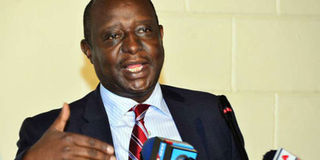Soaring national debt puts average taxpayers on survival mode

National Treasury Cabinet Secretary Henry Rotich speaks during a press briefing about the economy, at Intercontinental Hotel on November 9, 2017. He announced publicly that the government was hard-pressed for money. PHOTO | SALATON NJAU | NATION MEDIA GROUP
What you need to know:
- In the short run, more debt means that the government will be forced to raise taxes to meet its debt obligations.
- But a high debt ratio will also mean austerity. Government will reduce expenditure significantly to survive through its decisions.
On average, each Kenyan owes Sh110,000. The national debt stands at Sh4.4 trillion and is growing fast.
With an estimated per capita income of Sh127,000, almost all of the income generated by the Kenyan population is earmarked for taxation and thereafter loan repayment.
As the dust clears after an extended election process that cost the country over Sh120 billion, the Finance Cabinet Secretary announced publicly that the government was hard-pressed for money and was planning to borrow more money to repay the syndicated loan of Sh77 billion and sustain recurrent expenditure.
LOANS
All the while, the Kenyan debt burden is now well over 55 per cent of the GDP. This is a ticking time bomb.
To be fair, borrowing is not bad. Many countries have developed great infrastructure that spurred their economies from borrowed funds.
The plan to finance the standard gauge railway (SGR), Lamu Port and other Vision 2030 projects through debt financing was not downright wrong.
It is however worth noting that a better strategy of a public private partnership could have been sought to reduce the debt burden.
INVESTMENT
The Kenyan policy problem has been in implementation, or in this case, prudent use of debt.
The government successfully acquired a Eurobond whose use is unclear to date.
SGR cost Kenyans over Sh300 billion, money borrowed from the Chinese government.
It is however a single track non-electric railway that does not solve immediate problems of connectivity in the country and region.
In the end, these investments are not creating the much needed ripple effect in the economy as would be expected.
ECONOMY
We thus have a case of borrowed money that requires repayment, with no extra income or economic benefits from their investment.
In 2009 after the economic recession, Greece announced that it had all along under-quoted its deficits and was thus unable to service its large debt burden.
What followed was a series of talks that led to a bailout plan, which, sadly, has not worked to date.
The country’s economy has shrunk by a quarter and currently facing high unemployment figure of 25 per cent.
Closer home, General Idi Amin of Uganda wrecked the country’s economy in the 70s by constant borrowing to invest in the military, without a complementary initiative to drive business and investment.
WORLD BANK
Historically, Kenya has been here before. Under the reign of President Daniel arap Moi, there was consistent borrowing to meet government obligations without proper policies to foster economic growth.
Many banks were run down in the process. The result was a shrinking economy throughout his final term.
Often times the World Bank has cautioned that many African nations, Kenya included, are still vulnerable to economic shocks.
Any social or economic tremors like recessions, terrorism, wars or in our case boycotts can have very unpleasant repercussions like Greece or Idi Amin’s Uganda.
The announcement by Treasury is ill advised.
AUSTERITY
In the short run, more debt means that the government will be forced to raise taxes to meet its debt obligations.
So far, it is reported that the Kenyan government spends about Sh460 billion, about half of its collected revenue, to service its debts. This will come from average Kenyans.
But a high debt ratio will also mean austerity. Government will reduce expenditure significantly to survive through its decisions.
This means no transfer payments, reduced spending on social needs, abandoned projects, truncated salaries or allowances and layoffs.
It is likely that we will see longer and bigger strikes in response to this austerity. More borrowing means more taxes and fewer jobs.
DISPOSABLE INCOME
The ultimate loss is on economic growth. Good intentions notwithstanding, the current debt regime will not help us realise Vision 2030.
Already, Moody's, a rating company, has commenced discussions to lower the Kenya’s rating in the international markets.
Lower ratings make debt expensive and unattainable in many instances.
If a Kenyan earning Sh1,000 borrows five thousand for a year at 20 per cent interest rate, he will have to repay Sh500 per month.
While his income has not reduced, he will need to make adjustments to his expenditure.
There will be no more frivolous shopping or second tier social engagements.
He will no longer contribute generously to charity or invest monthly as he’s used to.
He will need to focus on survival. The new debt frontier puts the country on survival mode.
Mr Ramogi is an independent analyst. @Odhiamboramogi




